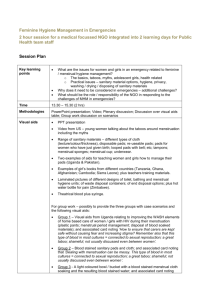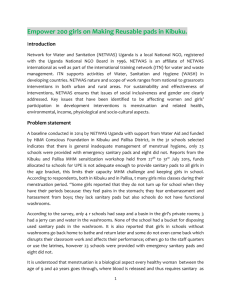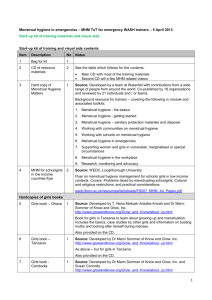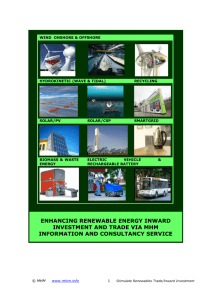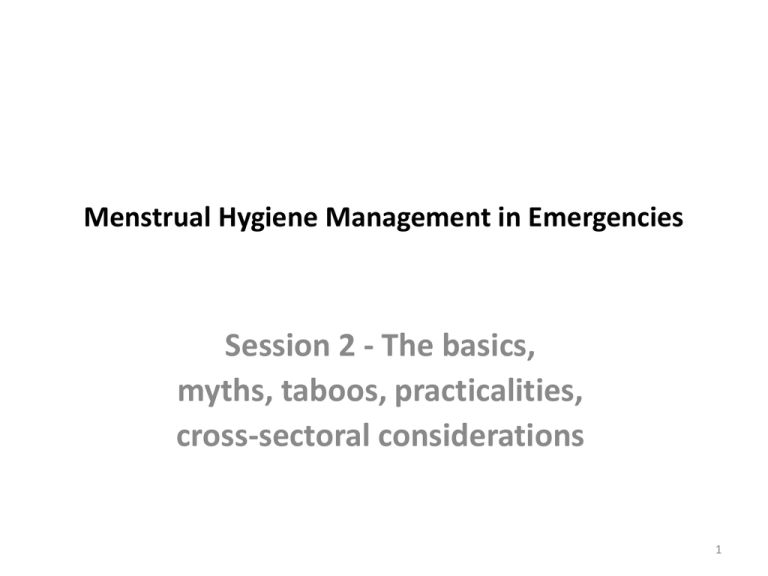
Menstrual Hygiene Management in Emergencies
Session 2 - The basics,
myths, taboos, practicalities,
cross-sectoral considerations
1
The world has around 7 billion people in it
Of which approx 3.5 billion are female
During any one month...
... approx 1.5-2 billion menstruate
Physical process
• Starts at menarche
(~ age 10 to 19)
• Ends at menopause
(~ late forties-fifties)
• 28 day cycle (21 to
35)
• If egg not fertilised
lining of uterus and
blood are shed
through vagina
Basics
MHM - M1
P: 24
• Bleeding 2 to 7 days
per month
3
Practically what does this mean for
women and girls?
Practically what does this mean for
women and girls... in an emergency
context?
4
What does this mean for women and girls?
• Very taboo – women don’t often discuss with women, mothers
don’t always discuss with daughters
• Girls reaching onset of menstruation – scared, not know what to do
• Myths, traditional practices – some can be dangerous / problematic
• Cost / availability of sanitary materials/washing/drying/disposing
• Need for water
• Need for privacy
• Poor hygiene practices
• Girls don’t go to school / loose time from school
Implications
MHM - M&T 1
Pp: 22-40
Pp: 213-236
• ...
5
What does this mean for women and
girls in an emergency context?
•
Lost old coping mechanisms
•
May not have access to usual sanitary
materials
•
Living in a tent with fathers, brothers,
uncles, strangers
•
May not have a gender segregated private
location to bathe
•
May not have adequate volumes of water
•
May not have a container to soak or wash
cloths
•
Where to dispose of soiled menstrual
materials
•
Nowhere private to dry their cloths
•
...
Implications emergencies
MHM - M6
PP: 131
6
Taboos and myths
http://www.adweek.com/news/advertisingbranding/straight-talk-menstruation-ad-thatscausing-quite-stir-147501
7
Examples of
restrictions on
girls during their
menstrual
period in
Afghanistan,
India, Iran and
Nepal
Cultural and
religious
beliefs, norms
and myths
MHM - M&T 1
Pp: 25-29
Pp: 213-215
8
Health and ‘menstrual hygiene’
• Limited / patchy documented evidence of link between menstrual
hygiene and health
• Except Toxic Shock Syndrome (rare condition)
• Issues around insertion of unhygienic materials into vagina
• Douching (forcing liquid into the vagina) - increased incidences
Thrush & Bacterial Vaginosis
• Use of damp cloths, or using a soiled cloth for too long – irritations
Health & MH
MHM - M&T 1
Pp: 32-37
Pp: 227-236
9
Health and ‘menstrual hygiene’
• Vaginitis due to allergic reactions to sanitary products - women with
sensitive skin
• Risk of disease transmission from poor handling of menstrual blood
– such as HIV, HepB (with ARVs – women with HIV menstruating)
• Physiological stress – concern over smell, leaks, how to manage
menstruation
• May prevent engagement in schooling or other activities
• Transactional sex to buy sanitary protection materials
Impacts on
schoolgirls
MHM - M&T 1
Pp: 32-37
Pp: 227-236
Health & MH
MHM - M&T 1
Pp: 32-37
Pp: 227-236
Health & MH
MHM - M&T 1
Pp: 32-37
Pp: 227-236
10
Health and ‘menstruation’
• Some risks possible of lower reproductive tract infections (RTIs)
moving to be upper RTIs and possible to turn into Pelvic
Inflammatory Diseases (PIDs) – due to increased penetrability of
the cervical mucus and menstrual blood moving back into the
uterus, including during sexual intercourse
• Women who have had infibulation undertaken – can have blockages
/ clots and increased pain during menses
• Men may make the decision on when the wife can seek health
treatment – reluctance to discuss reproductive health issues
FGM
MHM - T7
P: 331
Health & MH
MHM - M&T 1
Pp: 32-37
Pp: 227-236
11
Health and ‘menstruation’
• Pre-menstrual syndrome (PMS)
• Heavy and prolonged bleeding (Menorrhagia)
• Pain, back aches, abdominal pains, cramps (Dysmenorrhoea)
• Risk of transmitting HIV, HepB etc increases during sexual
intercourse during menses (woman to man)
• Risk of Bacterial Vaginosis and Trichomonas Vaginalis can increase
during menses
Health & MH
MHM - M&T 1
Pp: 32-37
Pp: 227-236
12
Not related to menstruation but may
use menstrual products
• Fistula
• Urinary incontinence
• Faecal incontinence
Fistula - can occur e.g.:
• Young girls following protracted labour
• Result of rape
• Following pelvic operation
Menstrual products
however not ideal – as
liquid volumes tend to be
higher with incontinence
Urinary incontinence – can occur e.g.:
• Elderly
• After child birth
Incontinence
MHM - T7
P: 330
• Unlucky with urinary system functioning
• One in three women expected to suffer
from urinary incontinence in their lifetime
13
Why should menstrual hygiene be
considered in emergency contexts?
14
Why MHM should be responded to in
emergency contexts?
1.
Hygiene - meeting adolescent girls’ and women’s hygiene needs
2.
Protection – dangers for adolescent girls and women not provided with
adequate safe facilities (GBV) and adequate sanitary materials (including
transactional sex)
3.
Dignity - crucial for girls and women to feel confident to engage in
survival and other daily activities
4.
Practicality for survival - girls and women may have to queue for long
periods for life saving food, water or other provisions for essential needs
5.
Education - can lead to girls missing school
Adapted from Sommer, M (2011) Waterlines
15
WASH
Protection
Health
MHM in
emergencies
Community
Services
(UNHCR)
Logistics
Cross-sectoral
MHM - M2
Pp: 48-50
Shelter
16
Boys and men’s
need for
information on
MHM?
Boys and men
MHM - M2
Pp: 56-59
17
Should male staff be directly involved in
discussing menstrual hygiene with
women and girls affected by
emergencies?
18
Training staff, building confidence
Training of UNHCR and partners on MHM,
Uganda
Getting started
MHM - M2 & T6
Pp: 51-55
PP: 318-20
19
Training staff, building confidence
• Encourage talking about
MHM – breaking the
silence
• Sharing information
• Opportunities for male
staff to also learn and
build confidence in
discussing MHM
Training of UNHCR and partners on MHM, Uganda
20
Menstrual Hygiene Matters
A resource for improving menstrual
hygiene around the world
21
Team:
Therese Mahon, Sue Cavill and Sarah House
Contributors:
Collaborative approach – inputs from individuals and organisations across the
world - Reviewed by 21 experts including MSF - Co-published by 18 organisations
Jointly funded by:
UK Aid from the UK Department for International Development (DFID) under the
SHARE Project and WaterAid
22
Modules & Toolkits
3 – Sanitary protection
materials and disposal
9 – Research,
4 – Working with
monitoring and
advocacy
communities on
menstrual hygiene
1 – Menstrual hygiene – the
basics
8 – Menstrual
hygiene in the
workplace
2 – Menstrual hygiene –
getting started
7 – Supporting girls and
women in vulnerable,
marginalised or special
circumstances
5 – Working with
schools on menstrual
hygiene
6 – Working in
emergencies on
menstrual hygiene
23
Module & Toolkit 1 – The basics
•
Why considering menstrual hygiene is
important for all
•
What is menstruation?
•
Cultural and religious beliefs, social
norms and myths on menstrual
hygiene
•
Girls’ first experiences on menstruation
•
Girls’ experiences of menstrual hygiene
in school and their impact
•
Health problems related to menstrual
hygiene
•
How women and girls can keep
themselves healthy during their
menstrual period
24
Module & Toolkit 6 - Menstrual
hygiene management in emergencies
•
Getting started
•
Standards and guidelines on
menstrual hygiene in emergencies
•
Practical menstrual hygiene
interventions in emergencies
__________________
•
Specific examples relevant to
emergencies also in other modules:
– Module 3 – Re-usable pads made by
women refugees in Dadaab Refugee
camp , Kenya
– Module 7 - MakaPads (made from
Papyrus) made by women and men
abducted by the Lords Resistance Army,
Uganda
25
Standards and guidelines relating to
MHM in emergencies
Sphere
MHM - M6
Pp: 136-8
UNHCR
MHM - M6
P: 139
Inter-Agency Network for Education
in Emergencies – Gender responsive
school sanitation, health & hygiene
MHM - M6
Pp: 140-1
26
Sphere
Increasingly detailed mention of MHM from 2000, 2004, 2011 versions
Focussed on:
– Consulting users on selection and design
– Privacy of latrines / toilets
– Provision of private washing areas
– Provision of sanitary materials
– Availability of disposal mechanisms
Gaps:
– No mention of water in latrines
– Could have been stronger on providing screening latrines and bathing units for
privacy, increasing sizes of units
– No family plastic washing basin included in priority NFIs, no mention of issues
around only one basin for washing cloths and dishes
27
Accessing the Menstrual Hygiene
Matters manual
• Free download (complete
copy or by module, high and
lower resolutions) from:
www.wateraid.org/mhm
28
UNICEF research into MHM in
emergencies 2012
Hayden, T (2012) Menstrual Hygiene
Management in Emergencies: Taking stock of
support from UNICEF and partners
Handout – summary of findings
Handout (later) – FGD questions
Full report on resource CD
29

